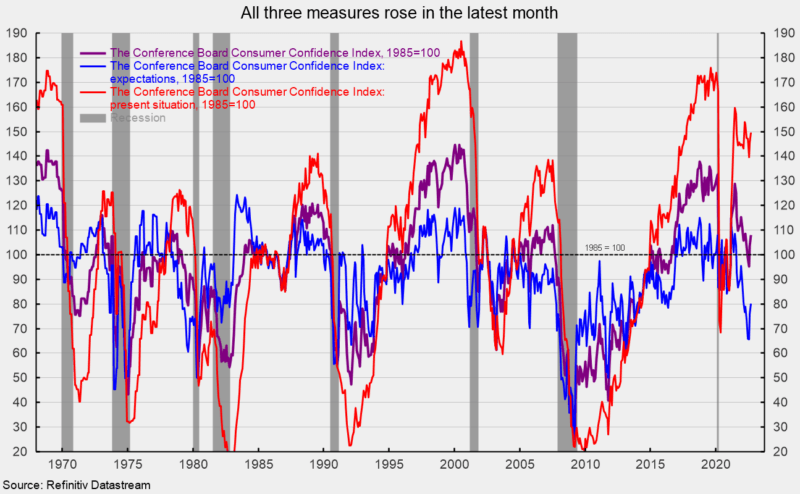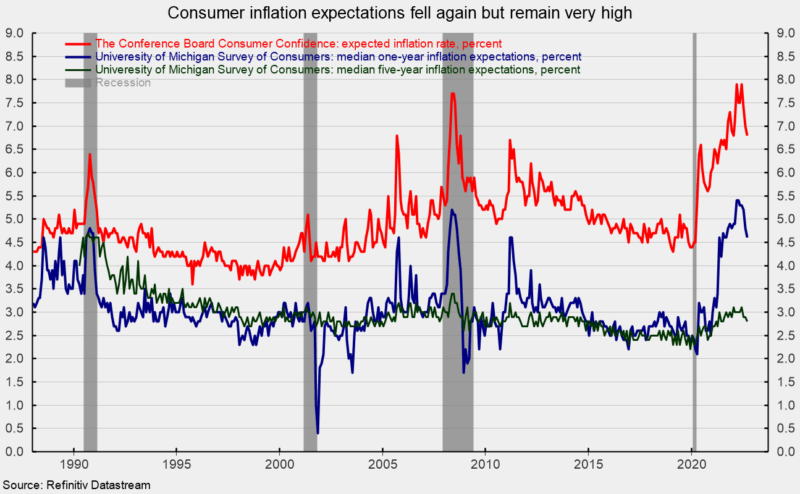Consumer Confidence Rose Again in September, but Risks Remain
The Consumer Confidence Index from The Conference Board rose in September, the second consecutive increase following three consecutive monthly declines. The composite index increased by 4.4 points, or 4.2 percent, to 108.0 (see first chart). From a year ago, the index is still down 1.6 percent. Both components gained in September.
The expectations component added 4.5 points, or 5.9 percent, to 80.3 (see first chart) while the present-situation component – one of AIER’s Roughly Coincident Indicators – rose 4.3 points to 149.6 (see first chart). The present situation index is up 3.7 percent over the past year while the expectations index is down 7.4 percent from a year ago. The present situation index remains consistent with economic expansion while the expectations index remains consistent with prior recessions (see first chart).
Within the expectations index, all three components improved versus August. The index for expectations for higher income gained 1.8 points to 18.4 while the index for expectations for lower income rose 0.4 points, leaving the net (expected higher income – expected lower income) up 1.4 points to 4.1.
The index for expectations for better business conditions rose 2.0 points to 19.3 while the index for expected worse conditions fell 0.7 points, leaving the net (expected business conditions better – expected business conditions worse) up 2.7 points, but still at -1.7.
The outlook for the jobs market improved in September as the expectations for more jobs index increased 0.4 points to 17.5 while the expectations for fewer jobs index fell by 1.9 points to 17.7, putting the net up 2.3 points to -0.2. Current business conditions and current employment conditions improved for the present situation index components. The net reading for current business conditions (current business conditions good – current business conditions bad) was -0.4 in September, up from -3.6 in August. Current views for the labor market saw the jobs hard to get index decrease, falling 0.2 point to 11.4 while the jobs plentiful index rose 1.8 points to a strong 49.4 resulting in a 2.0-point rise in the net to 38.0.
Inflation expectations eased down to 6.8 percent in September from 7.0 percent in August; expectations were 4.4 percent in January 2020 (see second chart). The drop was largely a function of falling gasoline prices. The trend in expected inflation from The Conference Board survey is consistent with the University of Michigan survey results, though the magnitudes are different (see second chart). Inflation expectations remain extremely high as prices for many goods and services continue to rise at an elevated pace. Since the end of the lockdown recession, the surge in prices for many consumer goods and services is largely a function of shortages of materials, a tight labor market, and logistical issues that prevent supply from meeting a post-lockdown-recession surge in demand. However, there has been significant progress in boosting production. Price pressures have been compounded by periodic lockdowns in China and the fallout due to the Russian invasion of Ukraine. Furthermore, an aggressive Fed tightening cycle raises the risk of a policy mistake and adds to the extreme level of risk and uncertainty in the overall economic outlook.







